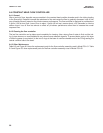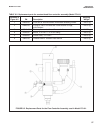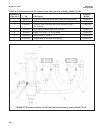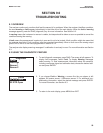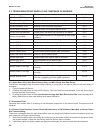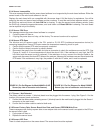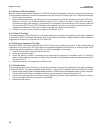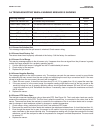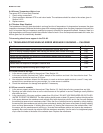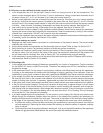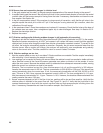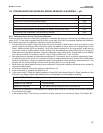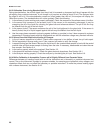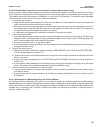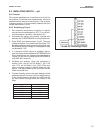
64
MODEL FCL-1056 SECTION 9.0
TROUBLESHOOTING
9.4.6 Sensor Temperature High or Low
The sensor RTD is most likely miswired.
1. Check wiring connections.
2. Check resistance between RTD in and return leads. The resistance should be close to the values given in
Section 9.10.2.
3. Replace sensor.
9.4.7 Broken Glass Disabled
The impedance of the pH glass electrode is a strong function of temperature. As temperature increases, the glass
impedance decreases. Because the broken glass fault message appears when the glass impedance becomes too
low, it is important that low impedance readings be properly corrected for temperature effects. However, there is a
high temperature cutoff beyond which the correction does not work. Once the temperature exceeds this value, the
broken glass fault is automatically disabled.
This warning should never appear in the FCL-02.
9.5 TROUBLESHOOTING WHEN NO ERROR MESSAGE IS SHOWING — CHLORINE
Problem See Section
Zero current was accepted, but the current is substantially greater than 10 nA 9.5.1
Error or warning message appears while zeroing the sensor (zero current is too high) 9.5.1
Zero current is unstable 9.5.2
Sensor can be calibrated, but sensitivity is significantly different from 350 nA/ppm 9.5.3
Process readings are erratic 9.5.4
Readings drift 9.5.5
Sensor does not respond to changes in chlorine level 9.5.6
Chlorine reading spikes following rapid change in pH 9.5.7
9.5.1 Zero current is too high
1. Is the sensor properly wired to the analyzer? See Section 3.2.
2. Is the zero solution chlorine-free? Take a sample of the solution and test it for free chlorine level. The
concentration should be less than 0.02 ppm.
3. Has adequate time been allowed for the sensor to reach a minimum stable residual current? It may take
several hours, sometimes as long as overnight, for a new sensor to stabilize.
4. Check the membrane for damage and replace it if necessary.
9.5.2 Zero current is unstable
1. Is the sensor properly wired to the analyzer? See Section 3.2. Verify that all wiring connections are tight.
2. Readings are often erratic when a new or rebuilt sensor is first placed in service. Readings usually stabilize
after about an hour.
3. Is the conductivity of the zero solution greater than 50 µS/cm? DO NOT USE DEIONIZED OR DISTILLED
WATER TO ZERO THE SENSOR. The zero solution should contain at least 0.5 grams of sodium chloride per liter.
4. Is the space between the membrane and cathode filled with electrolyte solution and is the flow path between
the electrolyte reservoir and membrane clear? Often the flow of electrolyte can be started by simply holding
the sensor with the membrane end pointing down and sharply shaking the sensor a few times as though shaking
down a clinical thermometer. If shaking does not work, try clearing the holes around the cathode stem. Hold
the sensor with the membrane end pointing up. Unscrew the membrane retainer and remove the membrane
assembly. Be sure the wood ring remains with the membrane assembly. Use the end of a straightened paper
clip to clear the holes at the base of the cathode stem. Replace the membrane.



